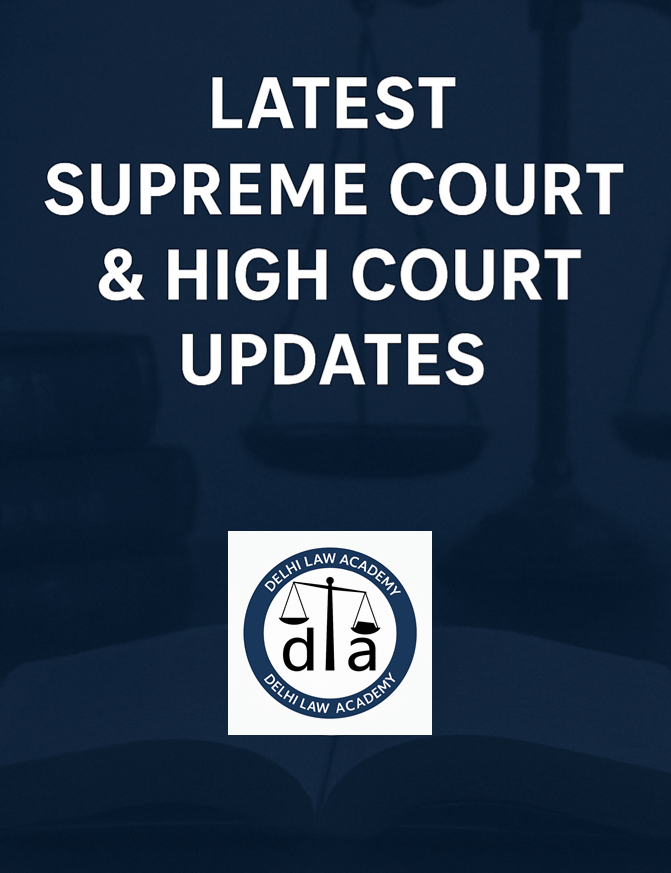
⚖️ Supreme Court Judgment in Navjot Singh Sidhu’s Case
TOPIC: Supreme Court Judgment in Navjot Singh Sidhu’s Case Presented below: Summarized version [by Delhi Law Academy Jaipur] of the Supreme Court Judgment in the case of Jaswinder Singh (Dead) v. Navjot Singh Sidhu delivered by a two-judge Bench comprising of A.M. Khanwilkar and Sanjay Kishan Kaul, JJ. on 19 May, 2022.
📌Jaswinder Singh (Dead) v. Navjot Singh Sidhu – JUDGMENT
Facts of the case: The original controversy emanates from an FIR dated 27.12.1988 under Section 304/34 Indian Penal Code on the basis of the information given by one Shri Jaswinder Singh about an occurrence around 12:30 p.m. at the traffic light of Battian Wala Chowk. The Informant and one Avtar Singh were travelling with the deceased, Gurnam Singh in a Maruti Car driven by the deceased. Apparently, a dispute arose on the right of way between the accused and the deceased and respondent No.1 (the first accused) came out of his vehicle, pulled out the deceased from his vehicle and inflicted fist blows. It was alleged that the car keys of the deceased’s car were removed by the accused and they fled from the scene of occurrence. PW-3 and PW-4 took the deceased in a rickshaw to the hospital where the doctors announced that Gurnam Singh was dead. The trial court post trial acquitted both the accused vide judgment dated 22.09.1999. In terms of the judgment of the trial court, the death was not caused by subdural haemorrhage and the deceased suffered sudden cardiac arrest under stress because of which he fell and received two abrasions leading to subdural haemorrhage. The death was caused due to violence but it was not certain as to when precisely Gurnam Singh had died. The High Court convicted respondent No.1 under Section 304 Part II of the IPC based on the testimony of the doctors, PW-1 and PW-2. As per their testimony, the cause of death was cardiac failure and all that they had stated was that the cardiac condition of the deceased was very weak. On the opening of the skull, subdural haemorrhage was present over the left parietal region and brain. It was the haemorrhage which caused the death of the deceased and not the cardiac arrest. Insofar as respondent No.2 is concerned, he was held guilty under Section 304 Part II read with Section 34 of the IPC as well as Section 323 of the IPC. Three criminal appeals were filed before this Court by the two accused and the Informant. The Court recognized that there were lapses in investigation but then people are not convicted on the basis of doubts. Respondent No.1 was held not guilty of causing the death of Gurnam Singh, and the only conclusion which was found acceptable was of the respondent No.1 causing voluntary hurt to Gurnam Singh which is punishable under Section 323 of the IPC. It was noticed that respondent No.1 was an international cricketer and a celebrity at the time of the incident and at times there was an endeavour to turn a blind eye to the violations of law committed by celebrities. On the question of sentence, a fine of Rs.1,000/- alone was imposed vide order dated 06.12.2006, since the incident was 30 years old at the time, there was no enmity between the parties and no weapon was used. A review application was filed by the complainant in which notice was issued on 11.09.2018 limited to the question of enlargement of sentence qua respondent no.1. Next we turn to the aspect of review, which persuaded us to issue the notice, i.e., qua the sentence imposed – a fine of Rs.1,000/-. No doubt the conviction is under Section 323 of the IPC relating to causing hurt. The punishment under Section 323 of the IPC has been prescribed as a sentence of a term which may extend to one year or a fine which may extend to Rs.1,000/- or both. In the present case, only the fine has been imposed. The question, thus, to be analysed is whether in the given factual scenario, grave error can be said to have been committed on the issue of sentence by not punishing with imprisonment of any term whatsoever. We have given our thought to the matter. In our view, some material aspects which were required to be taken note of appear to have been somehow missed out at the stage of sentencing, such as the physical fitness of respondent No.1 as he was an international cricketer, who was tall and well built and aware of the force of a blow that even his hand would carry. The blow was not inflicted on a person identically physically placed but a 65 year old person, more than double his age. Respondent No.1 cannot say that he did not know the effect of the blow or plead ignorance on this aspect. It is not as if someone has to remind him of the extent of the injury which could be caused by a blow inflicted by him. In the given circumstances, tempers may have been lost but then the consequences of the loss of temper must be borne. In fact, this Court to some extent had been indulgent in ultimately holding respondent No.1 guilty of an offence of simple hurt under Section 323 of the IPC. The question is whether even on sentence, mere passage of time can result in a fine of Rs.1,000/- being an adequate sentence where a person has lost his life by reason of the severity of blow inflicted by respondent No.1 with his hands. The hand can also be a weapon by itself where say a boxer, a wrestler or a cricketer or an extremely physically fit person inflicts the same. This may be understood where a blow may be given either by a physically fit person or to a more aged person. Insofar as the injury caused is concerned, this Court has accepted the plea of a single blow by hand being given on the head of the deceased. In our view, it is this significance which is an error apparent on the face of the record needing some remedial action. We would like to deliberate a little more in detail on the necessity of maintaining a reasonable proportion between the seriousness of the crime and the punishment. While a disproportionately severe sentence ought not to be passed, simultaneously it also does not clothe the law courts to award a sentence which would be manifestly inadequate, having due regard to the nature of the offence, since an inadequate sentence would fail to produce a deterrent effect on the society at large. An important aspect to be kept in mind is that any undue sympathy to impose inadequate sentence would do more harm to justice system and undermine the public confidence in the efficacy of law. The society can not long endure under serious threats and if the courts do not protect the injured, the injured would then resort to private vengeance and, therefore, it is the duty of every court to award proper sentence having regard to the nature of the offence and the manner in which it was executed or committed.10 It has, thus, been observed that the punishment to be awarded for a crime must not be irrelevant but it should conform to and be consistent with the atrocity and brutality with which the crime has been perpetrated Thus, a disproportionately light punishment humiliates and frustrates a victim of crime when the offender goes unpunished or is let off with a relatively minor punishment as the system pays no attention to the injured’s feelings. Indifference to the rights of the victim of crime is fast eroding the faith of the society in general and the victim of crime in particular in the criminal justice system. We are not setting forth much about how the investigation proceeded initially, how the court had to intervene to see that the relevant people are charged, the manner of leading of evidence, the hesitancy of doctors all of which weighed in this Court opining that a case beyond reasonable doubt could be only of one under Section 323 of the IPC. We do believe that the indulgence was not required to be shown at the stage of sentence by only imposing a sentence of fine and letting the respondent go without any imposition of sentence. The present case is not one where two views are possible such that review should not be exercised. It is a case where some germane facts for sentencing appear to have been lost sight of while imposing only a fine on respondent No.1 and, therefore, no question of choosing between two possible views arises
✅Conclusion
The result of the aforesaid is that the review applications/petitions are allowed to the aforesaid extent and in addition to the fine imposed we consider it appropriate to impose a sentence of imprisonment for a period of one year rigorous imprisonment to be undergone by respondent No.1.
Student Testimonials
Contact us
📍 Delhi Law Academy – Jaipur Branch
6C, Tower 2, Coaching Hub, Pratap Nagar, Jaipur – 302033
📞 Phone:
+91 9911916552,
+91 8447285606
✉️ Email:
contactus@delhilawacademy.com
🌐 Website:
www.delhilawacademy.com






